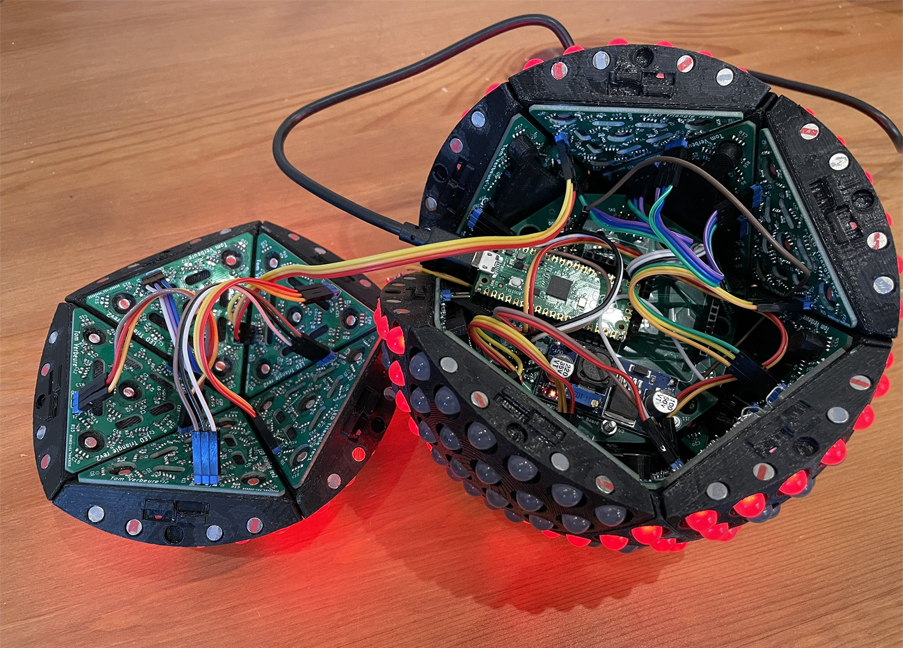Raspberry Pi RP2040 Sphere Bedazzles with Hundreds of Neopixels
We’ve seen Raspberry Pi-powered matrix cubes before but haven’t seen anything quite like this NeoPixel-covered sphere created by maker and developer Tom Verbeure. The bedazzled sphere is decked out with hundreds of RGB WS2812B LEDs that flash and illuminate with pre-programmed effects for a dazzling light show right at your fingertips.
Things are coming along! LEDs controlled by an RP2040, powered by 2 18650 cells. I’m using MicroPython for the first time. It’s not bad for fast prototyping stuff like this. pic.twitter.com/8lhYPNDAS5June 12, 2022
This project relies on our favorite microcontroller, the Raspberry Pi Pico making it one of the coolest RP2040 LED spheres around. In addition to the Pico, Verbeure had to create a custom PCB to mount the LEDs to in order to line everything up for the final product we see today. Everything is fitted together using 3D printed sections with custom mounts, jumper wires, and even batteries to make the unit totally mobile.
Verbeure is a hardware engineer at Nvidia and it’s clear that his skills are put to clever use in his free time. He has a huge library of past projects that lend from his expertise, many of which can be found on his profile at GitHub.io. No doubt this experience helped create the impressive spherical creation gracing our screens today.
The NeoPixel sphere is constructed with a custom 3D-printed frame designed to secure triangle-shaped PCBs that Verbeure fabricated just for this project. These PCBs fit nicely together and keep the LEDs evenly spaced in place. inside the sphere is the Raspberry Pi Pico which is connected to two 18650 batteries for power.
The Pico drives everything on the sphere including the LED PCBs and determining what animation to trigger. According to Verbeure, the software for the LED sphere was created using MicroPython (MP) and was actually Verbeure’s first time using MP.
If you want to recreate this Raspberry Pi project or draft something similar, your best bet is to check out the original thread shared to Twitter. You can also follow Tom Verbeure for future updates as there are plans in the works to share the source code with the public via a GitHub repo. In the meantime, definitely take a look at what he’s shared so far to see how it goes together and see the RGB LED sphere in action.
We’ve seen Raspberry Pi-powered matrix cubes before but haven’t seen anything quite like this NeoPixel-covered sphere created by maker and developer Tom Verbeure. The bedazzled sphere is decked out with hundreds of RGB WS2812B LEDs that flash and illuminate with pre-programmed effects for a dazzling light show right at your fingertips.
Things are coming along! LEDs controlled by an RP2040, powered by 2 18650 cells. I’m using MicroPython for the first time. It’s not bad for fast prototyping stuff like this. pic.twitter.com/8lhYPNDAS5June 12, 2022
This project relies on our favorite microcontroller, the Raspberry Pi Pico making it one of the coolest RP2040 LED spheres around. In addition to the Pico, Verbeure had to create a custom PCB to mount the LEDs to in order to line everything up for the final product we see today. Everything is fitted together using 3D printed sections with custom mounts, jumper wires, and even batteries to make the unit totally mobile.
Verbeure is a hardware engineer at Nvidia and it’s clear that his skills are put to clever use in his free time. He has a huge library of past projects that lend from his expertise, many of which can be found on his profile at GitHub.io. No doubt this experience helped create the impressive spherical creation gracing our screens today.

The NeoPixel sphere is constructed with a custom 3D-printed frame designed to secure triangle-shaped PCBs that Verbeure fabricated just for this project. These PCBs fit nicely together and keep the LEDs evenly spaced in place. inside the sphere is the Raspberry Pi Pico which is connected to two 18650 batteries for power.
The Pico drives everything on the sphere including the LED PCBs and determining what animation to trigger. According to Verbeure, the software for the LED sphere was created using MicroPython (MP) and was actually Verbeure’s first time using MP.
If you want to recreate this Raspberry Pi project or draft something similar, your best bet is to check out the original thread shared to Twitter. You can also follow Tom Verbeure for future updates as there are plans in the works to share the source code with the public via a GitHub repo. In the meantime, definitely take a look at what he’s shared so far to see how it goes together and see the RGB LED sphere in action.
